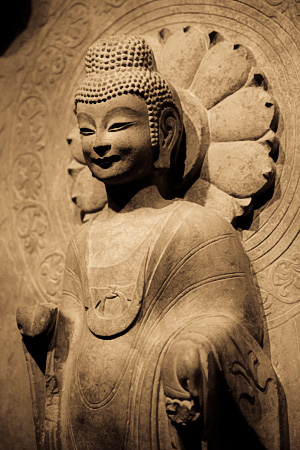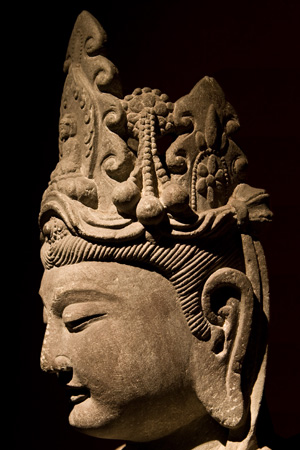Gurdjieff on the Visual Arts
A picture is worth a thousand words. But words are slow and and a picture is immediate: in one moment of clear perception, an image may impress upon us what only hours of reading can convey.
Gurdjieff on Emotions
Preparing the Emotional Center

Buddha – Wei Dynasty
Gurdjieff observed that benefiting from art required a sufficiently developed emotional center.
The emotional center is the quickest of all four lower centers (i.e. the emotional, moving, instinctive and intellectual centers). Its perceptions are instantaneous: we enter a room and immediately sense whether people are tired or happy or argumentative. We immediately sense whether someone is pleased or displeased with us, believes or mistrusts us, loves or fears us.
If our emotional speed of perception were directed to objective art, then a sculpture could instantly strike a deep cord in our being.
Normally, though, the emotional center is too undernourished to work in its proper speed. Its fine energy leaks through negative emotions. It is left with coarse fuel, like a sports car running on unrefined gas.
To bridge the gap between sleep and awakening, the emotional center must be brought up to speed. Work on not expressing negative emotions lays the groundwork for proper emotional perception. It prepares the heart to receive a higher form of nourishment, a finer fuel that will bring it closer to higher centers.
The Nourishment of Objective Art
Objective art is that nourishment. It carries the potential of transforming the onlooker. It conveys volumes of wisdom – as Gurdjieff observed in his travels – but this wisdom isn’t verbal. It is a wordless dose of energy, a potent breath of fresh inspiration.
Reality is instantaneous. To penetrate reality, there is no time for words. Therefore, the advantage of a picture over a thousand words lies in speed. Words speak to the intellectual center (the slowest of all lower centers) while images speak to the emotional center (the fastest of all lower centers). Objective art catapults the onlooker into the moment.
In other words, it transforms the emotional center into higher centers, bridging the gap between the lower and higher worlds in man.
Gurdjieff on Intelligent Art

Bodhisattva – Sui Dynasty
Early Buddhist sculpture aimed to achieve this effect. Finely carved Bodhisattvas greeted visitors to Buddhist shrines. They were incredibly animate, despite being made of dead stone. They seem to breathe and pay attention, to meet the visitor in person and welcome him home.
The visitor – often a pilgrim arriving after a long journey – is greeted by a profound visual representation of serenity and consciousness. If he pauses and lets the impression penetrate him – if he is emotionally prepared – the image may shock him into reality.
Examine the Bodhisattvas featured in this post. In an instant, they portray the many traits of enlightenment – traits that would take a book to describe: wisdom, compassion, awareness, contentment, concentration, flexibility, and many more. The sculptor has expressed in stone what the authors of the Dhammapada conveyed in writing. But being visual, his message enters the prepared heart instantly.
Ultimately, objective art strives to mirror objective man. It reflects, not only what he is, but also what he might become.
“In the whole statue there was nothing accidental, nothing without meaning. And gradually we understood the aim of the people who built this statue… That indeed was art!” – Gurdjieff